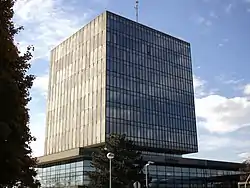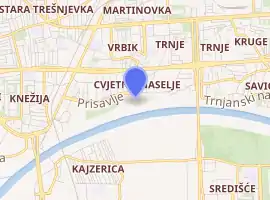Kockica
Kockica (Croatian for "Dice" or "Little Cube") is a 10-story mixed-use building located at Prisavlje 14 in Zagreb, the capital of Croatia. It was originally built to house the Central Committee of the League of Communists of Croatia, and currently serves as the headquarters of Ministry of Maritime Affairs, Transport and Infrastructure and Ministry of Tourism of Croatia. Croatian architect Ivan Vitić planned the building, which began construction in 1963. However, the construction was delayed due to the 1964 Sava river flood and the building was finished in 1968.
| Kockica | |
|---|---|
Zgrada ministarstava (Ministry Building) | |
 Kockica in 2010 | |

| |
| General information | |
| Status | Complete |
| Architectural style | Brutalist (Communist architecture)[1] |
| Location | Zagreb |
| Address | Prisavlje 14 |
| Coordinates | 45°47′26.4″N 15°58′07.8″E |
| Construction started | 1963 |
| Completed | 1968 |
| Opened | 1968 |
| Landlord | The Government of the Republic of Croatia |
| Height | roof 50 m (164 ft) |
| Technical details | |
| Floor count | 10[2] |
| Floor area | 14,500 m2 (156,000 sq ft)[2] |
| Design and construction | |
| Architect | Ivan Vitić |
| Main contractor | European Construction |
History
In 1961, the government of Croatia announced a tender for a new building to house the Central Committee of the League of Communists of Croatia. A first prize was not awarded; instead two second prizes were awarded. Ivan Vitić's design received the "first second" prize, while Boris Čipan and Petar Muličkovski from Skopje obtained the "second second" prize.[3] The construction only began in 1963,[4] as the building-to-be was located on undeveloped ground near the Sava river. The construction site was flooded in 1964, possibly inspiring Kockica's tall mezzanine.[3] The building was completed in 1968.[4] Because of its cubic shape, the citizens of Zagreb took to calling it the "little cube."[5]
The Building was originally conceived as the third part of the complex, which was supposed to include a large conference hall (which would be a similar hall for the UN skyscraper). However costs and overruns meant that part of the project has never been realized, but traces can still be seen today in form of the bridge supports, designed to connect the hall with the main building.[6]
Despite the bland outside appearance, the building's interior was richly decorated by the artists of the era.[7] Raoul Goldoni coordinated the effort and contributed artworks in glass, Jagoda Buić created the tapestry, while Stevan Luketić made the metal relief. The building also features mosaics by Zlatko Prica,[3] wall paintings by Edo Murtić[7] and at one time was home to a metal tapestry by Dušan Džamonja, which was stolen in the tumult of the 1990s.[2] The building is protected as cultural heritage of the Republic of Croatia.[4]
The Zagreb Tourist Board organizes free tours of Kockica with professional guides.[7]
See also
References
- https://www.kathmanduandbeyond.com/kockica-zagreb-croatia/
- "Karamarko o Kockici: Ne znam kako je to postalo prvorazredna politička tema" [Karamarko about Kockica: I do not know how this became a first-class political topic]. Croatian Radiotelevision (in Croatian). Zagreb. 13 January 2016. Retrieved 15 October 2016.
- "Kockica". Gradimo.hr (in Croatian). 29 October 2015. Retrieved 15 October 2016.
- "Galerija nepokretnih kulturnih dobara Grada Zagreba". City of Zagreb (in Croatian). Archived from the original on 5 March 2014. Retrieved 15 October 2016.
- Bilić, Josip; Ivanković, Hrvoje, eds. (2006). Zagrebački leksikon [Zagreb Lexicon]. A–LJ. Miroslav Krleža Institute of Lexicography. p. 531. ISBN 9531574863. OCLC 74895677.
- https://www.zagreb.info/ritam-grad/o-gradu/kockica-kako-je-nastao-simbol-jedne-ere/34634
- Bahun, Siniša (6 March 2014). "Visit Zagreb's Ex-commie Headquarters". Croatia Times. Hanza Media. Retrieved 7 July 2017.
External links
![]() Media related to Kockica at Wikimedia Commons
Media related to Kockica at Wikimedia Commons